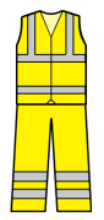- today
- label Guide
- favorite 0 likes
The EN ISO 20471 standard is the current version of the EN 471 standard. It specifies the requirements for high-visibility clothing that allows visual indication of presence in the user's traffic zone, for operators of vehicles or other mechanical devices, in all lighting conditions, both in daylight and and in the dark when illuminated by vehicle headlights. The EN ISO 20471 standard specifies the requirements for color and reflectivity, as well as the minimum surfaces and the arrangement of materials in protective clothing. In addition, it imposes an obligation to inform the user about the maximum number of cycles and the method of washing that can be subjected to clothing while maintaining an appropriate level of protection.
The standard maintains the division of clothing into 3 categories. They are determined on the basis of the minimum area of reflective materials given in m². Category 1 is the lowest category and category 3 has the highest level of visibility
|
Category 3 clothing |
Category 2 clothing |
Category 1 clothing |
|
|
Background material |
0,8 m² |
0,5 m² |
0,14 m² |
|
Reflective material |
0,2 m² |
0,13 m² |
0,10 m² |
|
A material with combined properties |
... |
... |
0,2 m² |
Category 2 |
Category 3 |
|
Medium degree of visibility |
The highest degree of visibility |
|
|
|
|
e.g. sleeveless vests, bedspreads, dungarees |
e.g. coats and jackets with sleeves, coveralls, two-piece clothes |
|
0,5 m² fluorescent material |
0,8 m² fluorescent material |
|
0,13 m² retroreflective material |
0,2 m² retroreflective material |
|
Risk level |
Factor influencing the level of risk |
The level of risk / characteristics of the garment |
|||
|
Vehicle speed |
Road user type |
||||
|
High risk ISO 20471 Class 3 |
> 60 km/h |
Passive |
High visibility |
|
|
|
High risk ISO 20471 Class 2 |
≤ 60 km/h |
||||
|
High risk ISO 20471 Class 1 |
≤ 30 km/h |
|
|||
|
Medium risk |
≤ 60 km/h |
Active |
Increased visibility |
|
|
|
≤ 15 km/h |
Passive |
|
|||
|
≤ 60 km/h |
Active |
||||
|
Low risk |
- |
- |
Visibility |
|
|


